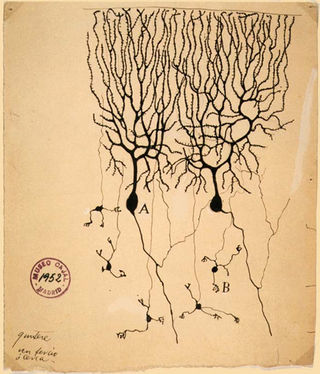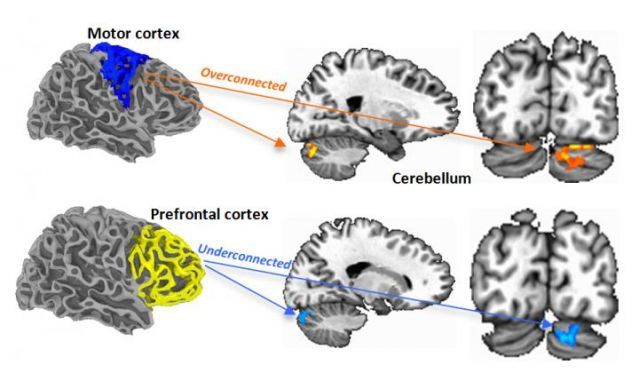Autism
Too Many Synaptic Connections in Cerebellum Creates Problems
Hyperconnectivity of cerebellar neurons is linked to learning difficulties.
Posted November 4, 2017

A new study on the detriments of too many synaptic connections in the mouse cerebellum by neuroscientists at the Washington University School of Medicine in St. Louis corroborates previous human research on autism spectrum disorders (ASD) and the cerebellum. The researchers found that mice with autism-associated genes who had too many cerebellar synapses also had tremendous difficulty learning new motor skills. (Cerebellar is the sister word to cerebral and means “relating to or located in the cerebellum.”)
The Washington University scientists speculate that having too many synaptic cerebellar connections disrupts communication within the cerebellum, which could be at the root of autism. These findings were published online, November 2, in the journal Nature Communications.
For this study, the researchers focused on a specific autism-associated gene called "ubiquitin RNF8" which regulates the number of synaptic connections in the cerebellum. Young mice without the RNF8 gene developed too many synaptic connections in the cerebellum. Over time, the researchers conducted a series of learning experiments on these mice compared to other mice with the RNF8 gene.
The cerebellum is responsible for fine-tuning motor control and balance. Notably, young mice both with and without the RNF8 cerebellar gene didn't display any obvious problems with their regular movements: As they scurried around their cages, all of the mice appeared to be coordinated.
However, in a surprising discovery, when the researchers specifically tested the ability of all the mice to learn new motor skills—such as an eye-blink test or performing a balancing act on a rolling cylinder—the mice without the RNF8 gene and too many synaptic connections became discombobulated and failed miserably. On the flip side, mice with the RNF8 gene and fewer synaptic connections in the cerebellum quickly mastered these new motor skills.
In a statement, senior author Azad Bonni, who heads the Department of Neuroscience at Washington University School of Medicine in St. Louis and is director of the Bonni Lab, said:
“This study raises the possibility that there may be too many synapses in the brains of patients with autism. You might think that having more synapses would make the brain work better, but that doesn’t seem to be the case. An increased number of synapses creates miscommunication among neurons in the developing brain that correlates with impairments in learning, although we don’t know how.”
Although the causal link between the cerebellum and autism remains enigmatic, countless other human and animal studies have correlated atypical functional connectivity and structural abnormalities of the cerebellum with autism.

Until recently, most medical experts thought the cerebellum was only involved with fine-tuning motor skills, maintaining balance, and the muscle memory necessary for doing things like riding a bicycle. However, there is growing evidence that the cerebellum may help fine-tune our thoughts and emotions much the same way it fine-tunes our motor movements as Jeremy Schmahmann of Harvard Medical School posits in his "Dysmetria of Thought" hypothesis.
Neural Darwinism and Pruning of Synapses Is Key to Neuroplasticity
During early child development, scaffolding is laid down within and between various regions throughout the entire brain—which includes both hemispheres of the cerebellum (Latin for "little brain") and both hemispheres of the cerebrum (Latin for "brain"). This creates a structural foundation for future neural networks that will either be pruned via neural Darwinism or fortified through a synaptic "fire and wire" process. Ideally, the brain prunes redundant synaptic connections to reduce clutter and streamline brain function, which optimizes the fluidity of thought and motion.
The common assumption that having more synapses firing always implies better brain function is a neuromyth. In fact, as mentioned earlier, having too many neural connections and synaptic formations appears to impede motor learning, whereas decreased neural activity when mastering a new skill is correlated with faster learning.

In 2014, a study from the University of Chicago Medical Center identified that a malfunction in the Purkinje cell pruning process within the cerebellum was correlated with a reduced capacity for motor learning in young mice. Using an autism mouse model, the researchers pinpointed that the ability of Purkinje cells to depress synaptic connectivity was greatly reduced in autism-like disorders. Purkinje cells either strengthen or depress the efficacy of their synapses. The inhibition of Purkinje cells is key to mastering complex fine-tuned motor skills such as playing a musical instrument, serving a tennis ball, touch typing without looking at the keyboard, etc.
Interestingly, the hyperactivity of Purkinje cells in both mice and humans is linked to impaired synaptic pruning in the cerebellum. The UChicago researchers also concluded that too much synaptic connectivity hindered the ability of the cerebellum to automatically fine-tune muscle movements necessary for fluid and coordinated motor learning.
In a statement, the study’s senior author Christian Hansel, professor of neurobiology at the University of Chicago and founder of the Hansel Lab, said,
"We have identified synaptic abnormalities that may play a role in motor problems typically seen in children with autism. Autism is sometimes described as intense world syndrome—too many, too strong excitatory connections that lead to enhanced sensory input. The results of our study might shed light on this phenomenon. Inefficient synaptic pruning seems to be a common motif in autism.”
Along this same line, in a 2015 study, cognitive neuroscientists at San Diego State University (SDSU) identified that functional connectivity between the cerebellum and the cerebral motor cortex was "overconnected" in children and adolescents with autism spectrum disorders.

The SDSU researchers also found that overconnectivity between the sensorimotor regions of the cerebellum and the cerebrum disrupted learning and cognition. It appears that the neural communication lines in children with ASD might be monopolized by sensorimotor connections before higher-order cognitive functional connectivity has a chance to become integrated with other communication networks throughout the entire brain.
These are exciting times for cerebellar research. State-of-the-art technology is beginning to help neuroscientists decrypt the mysterious role that the cerebellum plays in overall brain function, motor learning, and cognition. That said, much more research is needed before we truly understand how synaptic cerebellar connections influence autism spectrum disorders and facilitate learning. Please stay tuned for more cutting-edge empirical research on the cerebellum.
References
Pamela Valnegri, Ju Huang, Tomoko Yamada, Yue Yang, Luis A. Mejia, Ha Y. Cho, Anna Oldenborg, Azad Bonni. "RNF8/UBC13 ubiquitin signaling suppresses synapse formation in the mammalian brain." Nature Communications (Published online: November 2, 2017) DOI: 10.1038/s41467-017-01333-6
Khan, Amanda J., Aarti Nair, Christopher L. Keown, Michael C. Datko, Alan J. Lincoln, and Ralph-Axel Müller. "Cerebro-cerebellar resting-state functional connectivity in children and adolescents with autism spectrum disorder." Biological Psychiatry (2015) DOI: 10.1016/j.biopsych.2015.03.024
Piochon, Claire, Alexander D. Kloth, Giorgio Grasselli, Heather K. Titley, Hisako Nakayama, Kouichi Hashimoto, Vivian Wan et al. "Cerebellar plasticity and motor learning deficits in a copy number variation mouse model of autism." Nature Communications (2014) DOI: 10.1038/ncomms6586
Schmahmann, Jeremy D. "Dysmetria of Thought: Clinical Consequences of Cerebellar Dysfunction on Cognition and Affect." Trends in Cognitive Sciences (1998) DOI: 10.1016/S1364-6613(98)01218-2




